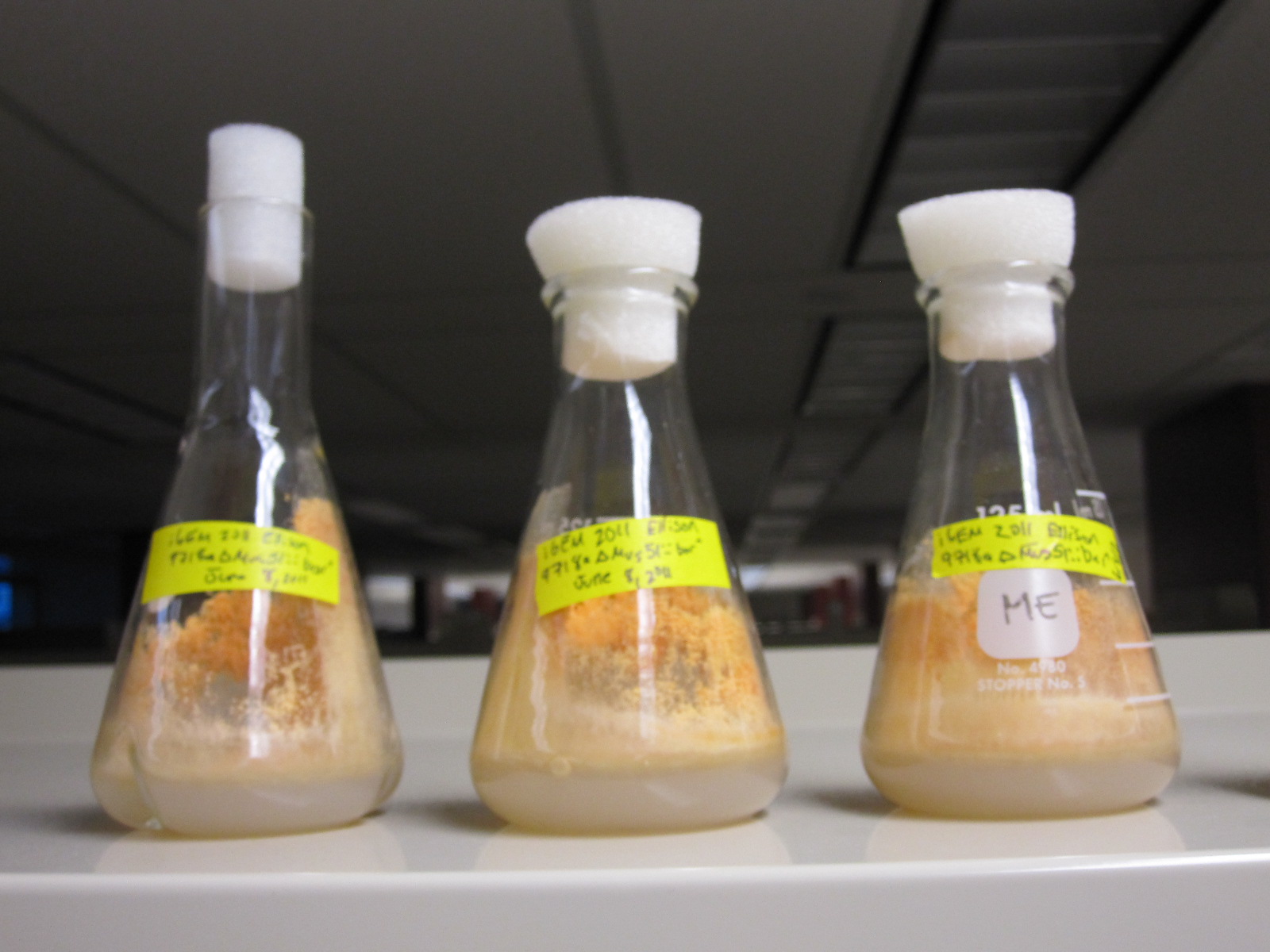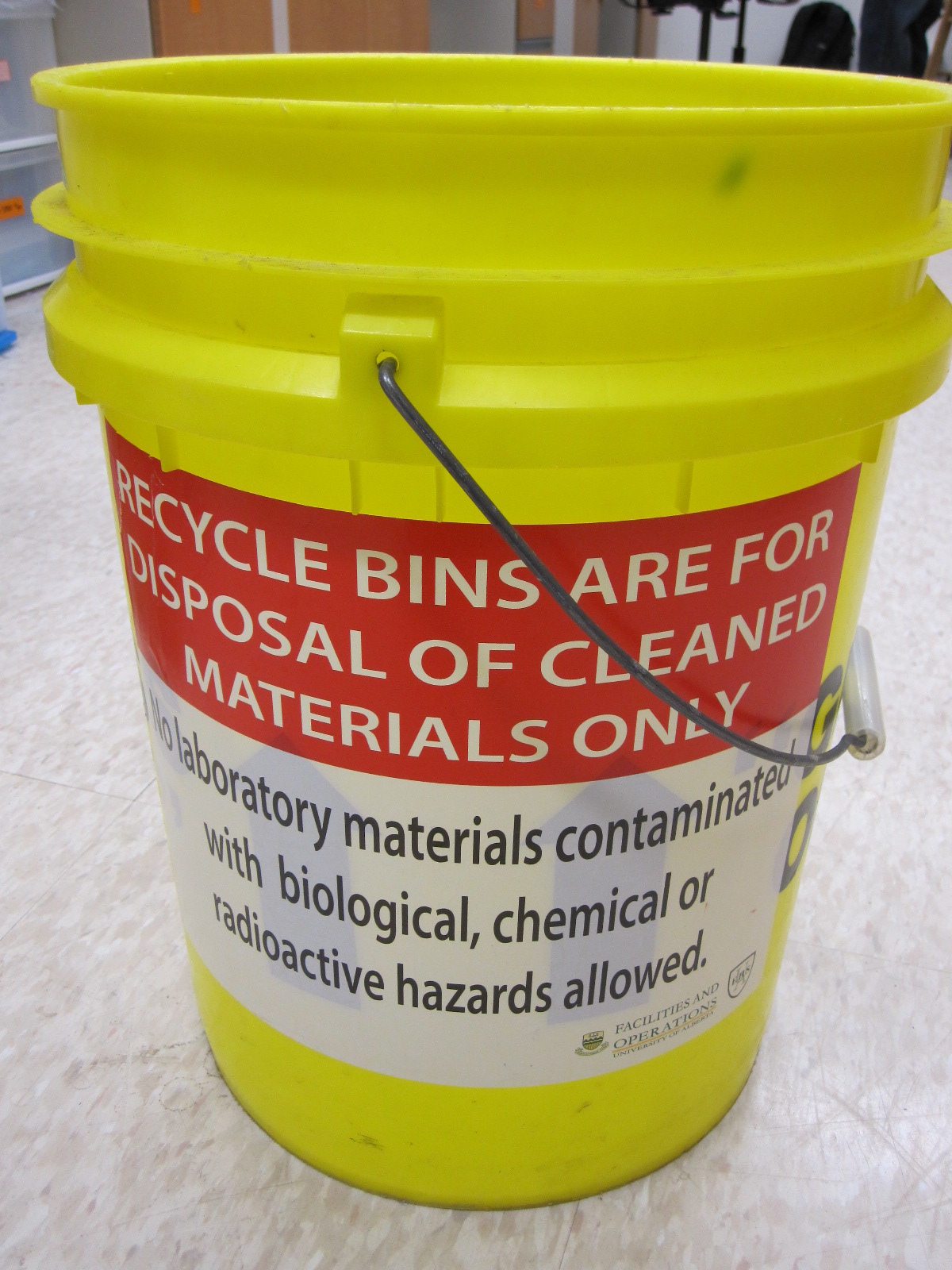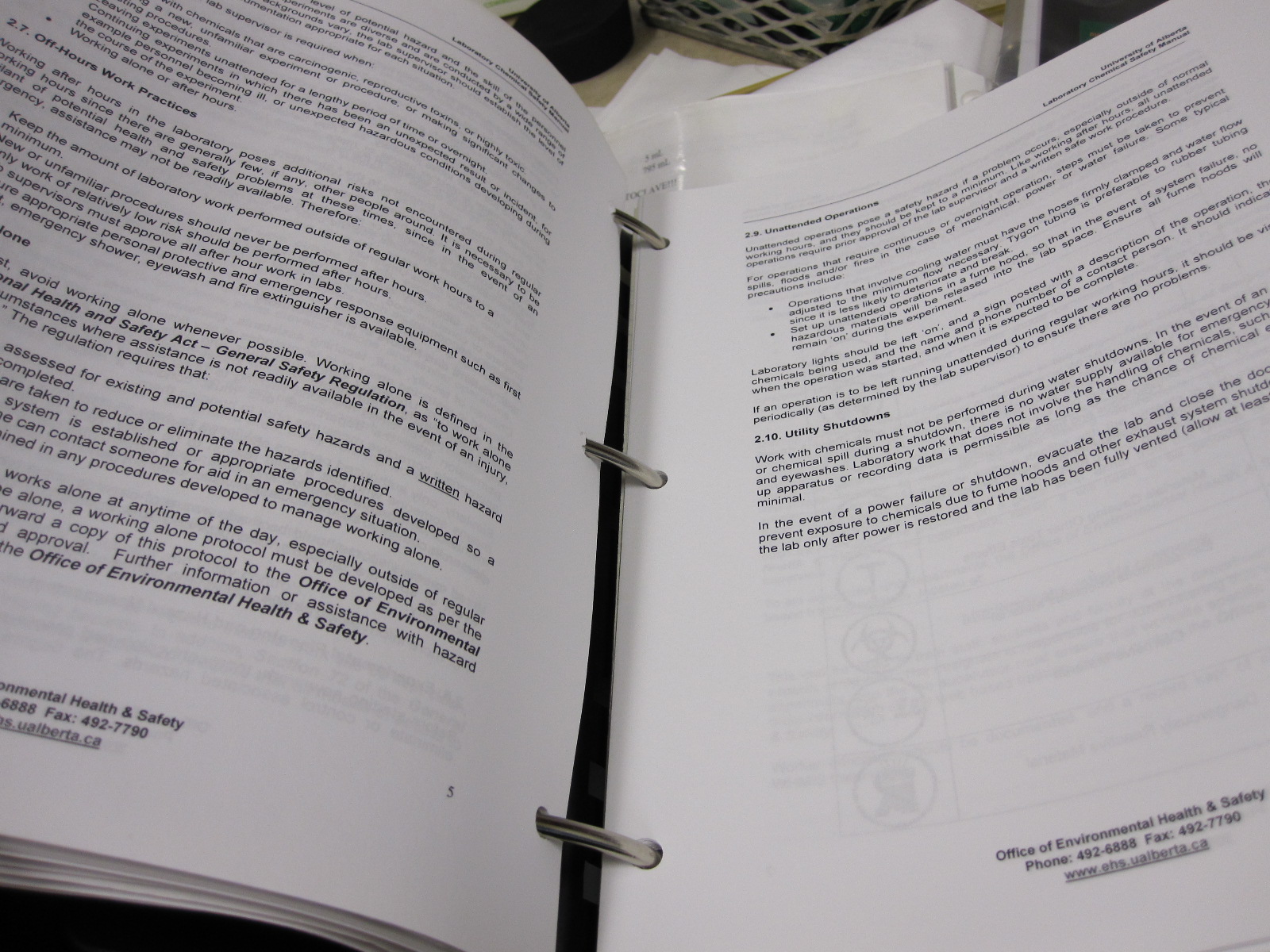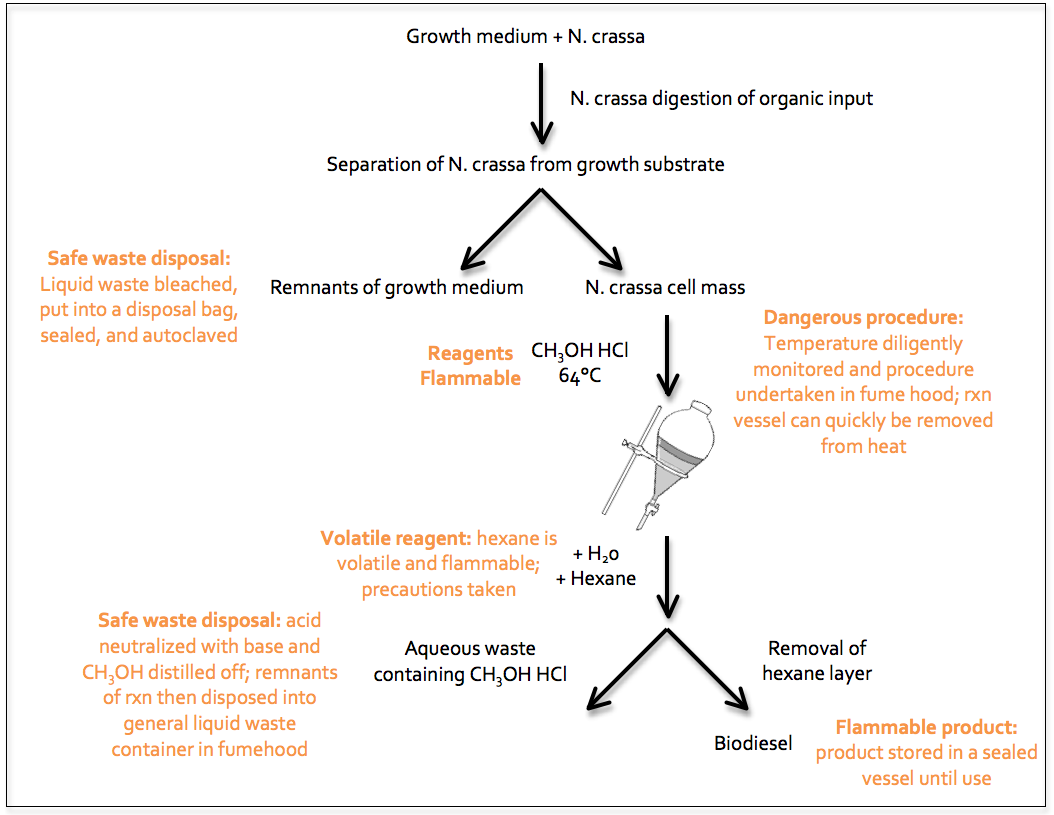Team:Alberta/Safety
From 2011.igem.org
m |
m |
||
| Line 58: | Line 58: | ||
<p>Our overall experimental procedure involves many steps. Most notably, the esterification portion of our procedure involves the greatest use of chemicals and reagents. We have therefore greatly scrutinized all steps within this procedure for potential hazards and have appropriately addressed all concerns (<i>please see the outline below</i>). </p> | <p>Our overall experimental procedure involves many steps. Most notably, the esterification portion of our procedure involves the greatest use of chemicals and reagents. We have therefore greatly scrutinized all steps within this procedure for potential hazards and have appropriately addressed all concerns (<i>please see the outline below</i>). </p> | ||
| + | <br> | ||
[[Image:TeamAlbertaReagentsAndChemicals.png|500px]] | [[Image:TeamAlbertaReagentsAndChemicals.png|500px]] | ||
Revision as of 04:56, 14 July 2011
Team Alberta iGEM Safety Proposal
Team Alberta recognizes the important role that safety plays in the completion of any scientific undertaking. Our team members are fully committed to not only ensuring the safety of those within our lab but also addressing any potential risks that our project may pose to the greater community.
1. Safety
1.1 Neurospora crassa
It is well documented that the organism that our group plans to genetically manipulate, Neurospora crassa, is safe1. Since 1941 the species has been used extensively in laboratories resulting in the publishing of thousands of research papers. In none of these numerous publications has the Neurospora genus been implicated in causing disease in either animals or plants1-4.
Neurospora’s minimal threat can largely be attributed to it being an obligate aerobe. Resultantly, unlike other species such as yeasts, Neurospora is unable to grow in organs such as the gut or bladder, tissues, or systemically within an organism1. Furthermore, despite Neurospora being regarded by some as an allergen, medical literature generally fails to mention the genus5-8.
Our team acknowledges that though certain fungal species themselves may not be pathogenic, they may produce dangerous toxins. Throughout our extensive research into Neurospora our group has not found documentation of the species producing dangerous mycotoxins or any dangerous secondary metabolites1. Given the Neurospora has had such a long history of living in close association with humans (please see below) the aforementioned facts are even moreso compelling1.
1.2 Reagents and Chemicals
In light of our procedure involving the use of many reagents and chemicals, each of our team members has received safety training (ex. WHMIS, etc.) on each of the materials we will be using. Moreover, data sheets for each of these materials are stored in an organized binder that is readily accessible to each team member.
Our overall experimental procedure involves many steps. Most notably, the esterification portion of our procedure involves the greatest use of chemicals and reagents. We have therefore greatly scrutinized all steps within this procedure for potential hazards and have appropriately addressed all concerns (please see the outline below).
1.3 Environmental Exposure
Effects of unforeseen release of Neurospora crassa into the environment must be considered. We asked ourselves what would happen if either our WT or manipulated organism were to be released into the environment.
Neurospora has a well-documented history of living in close association with humans. It is commonly regarded as having resided in a variety of businesses including bakeries, lumber yards and plywood factories1;9-11. Growth has also been observed on the stuble of burnt sugar cane fields and along burnt railway tracks13. However, these instances are largely documented as having occurred in moist tropical or subtropical environments, the favored climate for Neurospora growth1. Thus, if our organism, WT or manipulated, were to be released in our dry, temperate environment, Edmonton, Alberta, Canada, with its bitterly harsh winters, we would expect its survival and therefore impact to be minimal.
Nonetheless, as we discussed in the human practices component of our project, our alternative biodiesel has the potential to revolutionize economies throughout the world and we must therefore regard the effects of environmental exposure to Neurospora in other climates. Were Neurospora to be released in other warmer climates it may readily survive, creating its own niche within the environment. The aforementioned nonpathogenicity of the genus results in this not being a source of alarm1-4.
Team Alberta further predicts that our manipulated strain of Neurospora crassa would be disadvantaged to survive relative to WT in any environment: our genetic manipulation results in the organism’s energy being diverted away from other essential functions, inhibiting organismal growth and manipulation.
1.4 Biopart Malfunction
Unforeseen alteration of biopart functions may represent issues of concern. However, in our case if one or several of our bioparts were to change their function or stop working as intended, limited safety issues would arise. Our knockout of the FAD gene results in there being limited potential for its mutation and subsequent alteration of function. Further, our manipulation of thioesterases similarly represents limited safety concerns due to their prevalence in all organisms. If mutations were to occur in thioesterase genes and result in overproduction, our organism would likely die or have a limited existence; if mutation to thioesterase genes were to prevent its function, then the organism may return to a more WT phenotype12.
1.5 Device Malfunction
The malfunction of our bioconverter represents a potential threat to safety. The esterification process requires heat and flammable chemicals contained within a sealed vessel and thus the potential for serious injury undoubtedly exists. We addressed these areas of concern in our product design by incorporating various safeguards. For example, our bioconverter is designed to automatically turn off upon exceeding the recommended temperature and pressure past specific margins.
1.6 Cumulative Risk Assessment
Hazards
Any of the above mentioned areas of concern represent potential hazards that may be associated with our project. Throughout our project’s design and continued development, these were continually addressed and limited, where possible.
Probability
The probability of our project resulting in any harm to members of our lab, the community, or the environment is very low. This minimal probability can be attributed to our team’s careful consideration of the potential safety concerns associated with the completion of our project; our careful documentation and safety training have allowed us to work both responsibly and cautiously thus limiting the probability of injuries. Of course, if these practices were to subside, the probability of injury would proportionally increase.
As mentioned before, our team plans to develop a contained bioconverter within which all the processes needed to carry out the production of our alternative biodiesel are to be carried out; our team further aspires to scale-up this device for industrial production. Therefore, our project does not require the exposure or release of our engineered organism to people or the environment further limiting the probability of unfavorable events.
2. Documentation and management of safety issues
2.1 Safe Handling of Biobrick Parts and Devices
None of the genetic parts or devices that we have used or made this year raise any safety issues with the exception of our inserting a Hygromycin b resistance gene. The most predominant threat that this component possesses stems from our daily use of Hygromycin b in selection procedures. Hygromycin b is listed as potentially being fatal if absorbed through the skin or if swallowed. In addition, it is listed as being a hazard for birth defects, eye irritation, and respiratory tract irritation14. Our team diligently handled this area of concern by always wearing lab coats, safety goggles, and surgical masks when working with this potent antibiotic. Further, when our genetic parts are assembled into devices, no additional areas of concern arise.
It should also be noted environmental exposure of our Hygromycin b resistant strain does not pose a significant threat as our organism remains sensitize to other antifungal treatments such as Bleomycin15.
2.2 Registry Documentation
The potential safety issues arising from inserting a [[Hygromycin b resistance]] gene will be carefully documented when our created part is submitted to the registry. We plan to outline the aforementioned hazards and proper handling procedures in our submission.
2.3 Application to other teams
Team Alberta feels that the best way that other teams can learn from our experiences with Hygromycin b and engineering Hygromycin b resistance is from the careful documentation of our work. As previously mentioned, Team Alberta intends to outline the potential hazards associated with Hygromycin b exposure and procedures for its proper handling in our registry submission. This will afford future iGEM teams ease of access to information in determining how to safely handle the potent antibiotic and subsequently resistant strains.
3. Project Evaluation by University of Alberta Environmental Health and Safety
Team Alberta consulted the University of Alberta’s Office of Environmental Health and Safety throughout the planning of our project. The Biosafety Division of this office provides both technical expertise and support to labs throughout campus and thus ensures a safe working and learning environment for both staff and students. In addition, the division also monitors compliance with federal and provincial legislation16.
We have currently submitted a written overview of the relevant safety considerations associated with our project and we are patiently awaiting any final feedback that the Biosafety Officer may provide us with. Please check back shortly for an update.
4. Safety Considerations for Future iGEM Competitions
In order to motivate future iGEM teams to increasingly emphasize safety in their daily laboratory practices, we propose that each team completes a detailed safety report for a minimal medal requirement.
Our team recognizes that biosafety engineering has the potential to make many devices and systems safer. For example, knockouts may be created through partial or full deletions as oppose to single nucleotide alterations that are susceptible to mutation, auxtotrophic stains may be created, or antibiotic resistance may be removed. In our project, we are crossing out extraneous basta resistance found in mus strains from our final organism.
Bearing in mind the increasing importance of safety engineering, Team Alberta further proposes that future iGEM competitions require teams to engineer their parts to have several safeguards in order to achieve a gold medal. Such components being medal requirements, we feel that it would increasingly motivate iGEM participants to more actively address potential safety issues in their future work, iGEM or otherwise. Moreover, this would encourage teams to be more creative with respects to organismal engineering.
References
1. Perkins DD and Davis RH: Evidence for Safety of Neurospora Species for Academic and Commercial Use. Applied and Environmental Microbiology 2006, 66 (12): 5107-5109.
2. Davis RH: Neurospora: contributions of a model organism. Oxford University Press US; 2000.
3. Perkins DD: Neurospora: the organism behind the molecular revolution. Genetics 1992, 130: 687-701.
4. Perkins DD: Neurospora genetics at the turn of the century. Fungal Genetics Newsletter 2000, 47: 83-88.
5. Frank MM, Austen KF, Claman HN, Unanue ER: Samter’s immunological diseases, 5th ed. Little, Brown & Co US; 1995.
6. Kay AB: Allergy and allergic diseases. Blackwell US; 1997.
7. Middleton E, Reed CE, Ellis EF, Adkinson, NF, Yunginger, Busse, WW: Allergy: principles and practice, 5th ed. Mosby US; 1998.
8. Patterson R, Grammer LC, Greenberger PA: Allergic diseases: diagnosis and management, 5th ed. Lippncott-Raven US; 1997.
9. Shear CL, Dodge BO: Life histories and heterothallism of the red bread-mold fungi of the Monilia sitophila group. Journal Agricultural Research 1927, 34: 1019-1042.
10. Yassin S, Wheals A: Neurospora species in bakeries. Journal Applied Bacteriology 1992, 72: 337-380.
11. Shaw DE: Honeybees collecting Neurospora spores from steam Pinus logs in Queensland. Mycologist 1993, 7: 182-185.
12. Nelson DL, Cox MM: Lehninger Principles of Biochemistry. W.H Freeman US; 2009.
13. iGEM website: https://2011.igem.org/Safety
14. Hygromycin material and safety data sheet: http://www.invivogen.com/MSDS/ HygromycinB_solution_v4_MSDS.pdf
15. Kafer E, Luk D: Sensitivity of bleomycin and hydrogen peroxide of DNA repair-defective mutants in Neurospora crassa. Mutant Research 1989, 217(1): 75-81.
16. University of Alberta Environmental Health and Safety website: http://www.ehs.ualberta.ca/
 "
"












